In this blog, I am going to cover the essential physical and chemical properties of the two most common types of hydrocarbons, Alkane and Alkene. And also I am going to going to cover the physical and chemical properties of one of the most important hydrocarbon derivative, which is Alcohol. In the physical properties part, I am going to review the melting point, boiling point and solubility of each type of hydrocarbon. Also, I am going to give you a clear idea by comparing the the physical properties of Alkenes, Alkanes and Alcohols versus each other.
In the chemical properties part, I am going to cover the chemical reactions for Alkane, Alkenes and Alcohols. This will include reactions such as combustion, substitution, addition, hydration etc. After reading this blog post, your concepts about the physical and chemical properties of hydrocarbons will be cleared up 100%!
Before you start reading this blog post, I am assuming that you have some kind of idea about hydrocarbons. Even though I am going to cover very briefly about hydrocarbons, I think you should still have a quick look at my introductory blog post about hydrocarbons called “Hydrocarbon Classification, Names and General Formulas“. Just keep that blog post opened up in a separate tab of your browser and refer to it time to time when necessary.
In case you are absolutely new with organic chemistry, then I would recommend you read with this beginners book “Organic Chemistry I For Dummies (For Dummies (Lifestyle))” on Amazon. This will explain you everything right from scratch.
Quick Overview
What are Hydrocarbons?
Hydrocarbons are compounds made out of Carbon and Hydrogen atoms ONLY! Please have a look at the example below. Compound 1 is a hydrocarbon, because it consists of only hydrogen and carbon atoms. On the other hand Compound 2 is not a hydrocarbon, but a derivative of hydrocarbon, as it has an oxygen atom attached it.
Compound 1

- Is a Hydrocarbon: This compound is made of Hydrogen and Carbon ONLY.
Compound 2
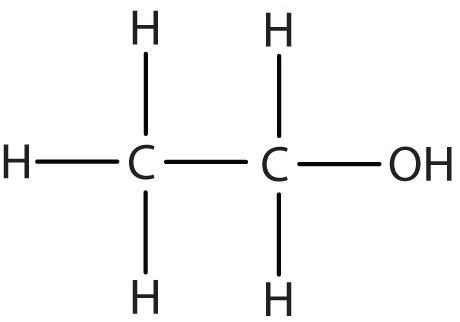
- Not a Hydrocarbon: Because apart from carbon and hydrogen it also contains an oxygen atom.
What is a Functional Group?
A functional group is an atom or group of atoms which give a homologous series unique chemical properties and similar physical properties. For example, in Alkene, the functional group is the carbon to carbon double bond (C=C). In alcohols, the functional group is the -OH group.
What is a Homologous Series?
The Homologous series is a family or group of hydrocarbons or derivatives having the same functional group, same general formula and similar chemical properties. They also have a similar trend in physical properties. For example, Alkane, Alkene and Alcohol are separate homologous series. They have different general formulas, chemical properties and may have different trends in physical properties. If you are not sure how to name them, then once again I would suggest you to have a look at this blog post I have written down “Hydrocarbon Classification, Names and General Formulas“. Also, if you are someone who is totally new to organic chemistry, then please read this blog “Best IGCSE Organic Chemistry Blog Complete Breakdown“.
So without further ado lets get start with the main topic of our blog “Physical and Chemical properties of hydrocarbons.
Physical Properties of Hydrocarbon
In this section, I am going to discuss about the physical properties of each of the homologous series. While explaining the different trends in physical properties, I will use the concepts of inter molecular forces. So if your concepts on inter molecular forces are not clear, then please have a quick look at my blog “Intermolecular Forces Notes“.
Physical Properties of Alkanes
Alkanes are the most simple type of hydrocarbons. There are only C-H bonds throughout the whole structure of alkanes. Alkanes do not have any functional group. Before I go on and start giving my explanation, in the table below I am listing down first five alkanes.
| Carbon Number | Name of Alkane | General Formula | Displayed Formula |
|---|---|---|---|
| 1 | Methane | CH4 |  |
| 2 | Ethane | C2H6 | 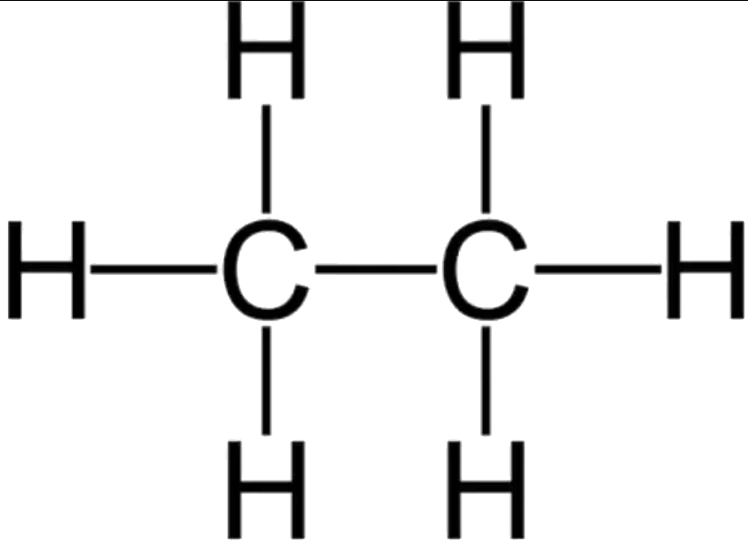 |
| 3 | Propane | C3H8 |  |
| 4 | Butane | C4H10 |  |
| 5 | Pentane | C5H12 |  |
From the table above you can see that as the number of carbon atom increases, the size of the molecule also increases. As there are more number of atoms, means there are more number of electrons, which means stronger intermolecular forces. So as the number of carbon atoms in alkanes increase, their melting and boiling points also increases. Most most of the lighter alkanes such as methane, ethane and propane are gas at room temperature, heavier alkanes such as Octane (8 carbon atoms) are liquid at room temperatures.
But alkanes only consists of C-H bonds throughout their structure. C-H bonds are non-polar, which means there are only weak London Forces present throughout their whole structure, strong inter molecular forces such Dipole-Dipole interactions and Hydrogen bonding are missing. Hence most alkanes have a low melting and boiling points in general. Most alkanes are usually volatile, they easily evaporate on heating.
Alkanes are completely insoluble in water, because in water there are stronger Hydrogen Bonding but in alkanes there are only weak London Forces. So alkanes do not dissolve in water.
Physical Properties of Alkenes
Alkenes have a carbon to carbon double bond in their structure or C=C for short. The carbon to carbon double bond is the functional group of alkenes, it gives them a unique chemical property and similar trends in physical properties. There are also C-H bonds throughout their structure. Both C=C and C-H bonds are non-polar, which means there are no strong dipole dipole interactions present. There are only weak london forces present between the molecules. Therefore alkenes have low melting and boiling points. Most of the alkenes are usually gases at room temperature. Below I have listed down the first four alkenes.
| Carbon Number | Alkene Name | Molecular Formula | Displayed Formula |
|---|---|---|---|
| 2 | Ethene | C2H4 |  |
| 3 | Propene | C3H6 | 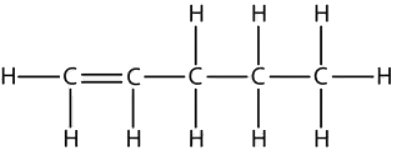 |
| 4 | Butene | C4H8 | 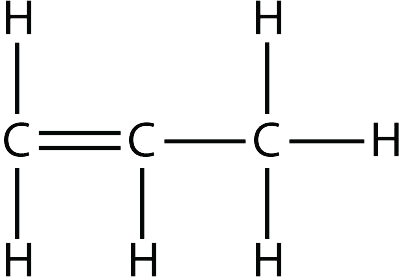 |
| 5 | Pentene | C5H10 | 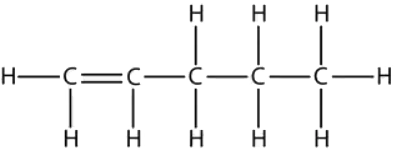 |
Also from the table above we can see that as the carbon number increases, the molecule gets bigger, which means more electrons and stronger intermolecular forces between the molecules. So we can also say about alkenes that as the number of carbon increases, the melting and boiling points of the alkenes also increases.
When it comes to solubility, alkenes are also insoluble in water just like alkanes are. Because also like alkanes, there are only weak london forces between the alkene molecules, while water molecules have a much stronger hydrogen bonding between them. Hence they do not mix.
Physical Properties of Alcohols
Alcohols have an -OH group present in their structure, the -OH group is the functional group of alcohols. That is bond between hydrogen and oxygen. The O-H bond is highly polar, which makes the alcohol molecules polar too. In fact they are so polar, that they form a very strong type of bond, called “Hydrogen Bonding”. This type of bonding is much stronger than the london forces. Therefore alcohols have much higher melting and boiling points when compared to both alkanes and alkenes. Most alcohols are usually liquid at room temperature.
Alcohols are highly soluble in water, because both water and alcohols are able to form hydrogen bonding with each other. They can form hydrogen bonding with each other and mix.
The three images below shows a molecule of methanol, next to it are methanol molecules forming hydrogen bonding with each other, and the third one shows methanol forming hydrogen bonding with water molecules.

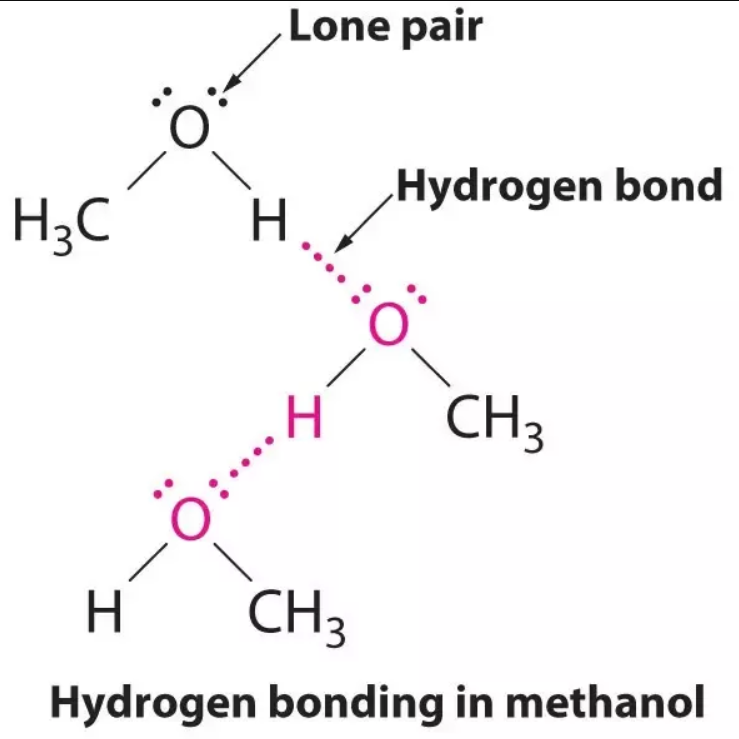
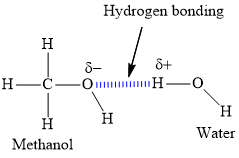
Summing Up the Physical Properties
- The melting and boiling points of both alkanes and alkenes increase as the carbon number increases.
- Alkanes have relatively higher melting and boiling points than alkenes. Because the presence of carbon to carbon double bond in Alkenes reduces the effectiveness of the intermolecular forces between the molecules.
- Both alkanes and alkenes are insoluble in water. Because their weak london forces cannot disrupt the much stronger hydrogen bonds between the water molecules.
- Alcohols have much higher melting and boiling points compared to alkanes and alkenes as they can form hydrogen bonds.
- Alcohols are highly soluble in water as they can form hydrogen bonding with the water molecules.
Chemical Properties of Hydrocarbon
Chemical Properties of Alkanes
There are no functional groups in alkanes. There are only C-H bonds throughout the whole structure of alkanes. The C-H bonds are quite stable and do not want to break easily, hence alkanes are quite inert or simply to say, they do not react easily.
Alkanes undergo only two reactions:
- 1. Combustion reaction with Oxygen
- 2. Substitution Reaction with Halogens
Combustion Reaction of Alkane with Oxygen
When an alkane reacts with oxygen water and oxygen is produced, given that there are plenty of supply of oxygen in the air. Below is the word equation:
Alkane + Oxygen ➝ Carbon dioxide + Water
Here is an example reaction between an alkane called methane and oxygen in a combustion reaction.
Methane + Oxygen ➝ Carbon dioxide + water
CH4(g) + 2O2(g)→ CO2(g) +2H2O(l)
(insufficient supply of oxygen causes incomplete combustion and produces carbon monoxide or soot(carbon) instead of carbon dioxide
Important Note, comes in IGCSE Chemistry exams: Carbon monoxide is a poisonous gas, it attaches with hemoglobin more efficiently than oxygen, which reduces the supply of oxygen to the brain and causes death.
Substitution reaction of alkane with halogens
Halogens are the elements in group 7, they all have 7 electrons in their outer shells. Some common halogens are Fluorine, Chlorine, Bromine and Iodine. Fluorine is the most reactive halogen, while iodine is the least reactive. When alkanes react with halogens the products are Hydrogen Halide and Halogenoalkane. But this reaction wouldn’t occur if they are simply mixed together. UV ray must be present in order for the reaction between an alkane and an halogen to occur. The UV ray provides the initial energy for the reaction to start. Sunlight instead of UV ray will also work, this is because UV ray is a part of sun light. Please have a look at the word equation below.
Alkane + Halogen ➝ Halogenoalkane + Hydrogen Halide
(Condition: Presence of UV Ray or sunlight)
Here is an example of reaction between the alkane methane and the halogen bromine:
Methane + Bromine ➝ Bromomethane + Hydrogen Bromide
CH4(g)+Br2(g)→CH3Br(g)+HBr(g)
Chemical Properties of Alkenes
In alkenes the functional group is carbon to carbon double bond ( C=C). This bond is quite unstable and breaks quite easily. Hence this make alkenes more reactive than alkanes. Unlike alkanes, alkenes undergo a lot of reactions. It is important to remember the names, reactants and the conditions in which the reactions take place. I am only going to include the reactions of alkenes which are included in the IGCSE chemistry syllabus.
Combustion (Reaction with Oxygen)
Just like alkanes, alkenes also react with oxygen in the air when it is ignited to produce carbon dioxide and water. But unlike alkanes they do not burn so cleanly. There are also no special conditions for this reaction, simply ignite the alkene in room temperature and normal atmospheric pressure, the reaction will occur naturally.
Name of Reaction: Combustion
Condition: Room temperature and 1 atm pressure
Alkene + Oxygen ➝ Carbon dioxide + Water
Example Reaction:
Ethene + Oxygen ➝ Carbon dioxide + water
C2H4(g)+O2(g)→ 2CO2(g)+2H2O(l)
Addition Reaction (Reaction with Halogens)
In this reaction, halogens react with alkenes. Unlike the substitution reaction this addition reaction does not need any presence of UV ray or sunlight. The reaction takes place normally at room temperature and pressure. The reaction is called “addition” because the two halogen atoms are being added to the hydrocarbon. There are no other biproducts, the end product is a dihalogenoalkane only.
Name of Reaction: Addition
Condition: room temperature and 1 atm pressue
Halogen + Alkene ➝ Dihalogenoalkane
Ethene + Bromine ➝ 1,2 dibromoethane
C2H4(g)+Br2(l)→ C2H4Br2(l)
Hydration (Reaction of ethene with steam)
In the hydration reaction, ethene is reacted with steam to produce ethanol. The ethanol which is produced by the hydration process is extremely pure. Ethanol is produced in this way only in factories, as it not possible to setup the required conditions in a laboratory. The ethanol produced in this process is mainly used to make other kind of chemicals or everyday products like shampoo, detergents etc.
Name of Reaction: Hydration
Conditions: Temperature is 300 °C, pressure is 60-70 atm
Catalyst used: phosphoric acid
Ehtene + Steam ➝ Ethanol
C2H4(g)+ H2O(g)→C2H5OH(g)
Test for unsaturation (Testing for the presence of carbon to carbon double bonds)
When an organic compound have a carbon to carbon double bond, it is called unsaturated. All alkenes are unsaturated. There is a quick test which we can use to easily determine whether a compound is alkene or not. Bromine is a brown liquid, and bromine water(bromine mixed with water) is orange brown. So when an alkene is passed through the bromine water, the bromine water reacts with the alkene. The double bond breaks down, and the bromine is absorbed into to the hydrocarbon. As there will be no bromine anymore, the brown/orange brown color disappears.
Testing for Unsaturation:
Test: Pass the compound through brown/orange-brown bromine
Result: If the orange brown color of bromine/bromine water turns colorless, then the compound is unsaturated. In simple words, it contains carbon-carbon double bond, it is an alkene.
Chemical Properties of Alcohols
Similarly to alkenes, alcohols have a functional group, which is the OH bond. The OH bond is quite polar, it makes the alcohol quite reactive, hence the alcohol undergoes several chemical reactions. But in IGCSE we are not concerned how the OH makes the reaction happen, we are only concerned with some important reactions. We will need to remember their names and conditions which makes the reaction takes place.
Combustion (Reaction with Oxygen)
Just like alkanes and alkenes, alcohols also undergo combustion reaction. When ignited alcohols burn or react with oxygen to produce carbon dioxide and water. Alcohol is a very good fuel. Alcohol produced by the fermentation method to use it as a fuel is known as biofuel. To learn more about the how alcohol is produced from fermentation process, you can read my blog post “Production of Ethanol from Sugarcane“.
Alcohol + Oxygen ➝ Carbon dioxide + Water
Ethanol + Oxygen ➝ Carbon dioxide + Water
C2H5OH(l)+3O2(g)→2CO2(g)+3H2O(l)
Dehydration
Dehydration means loss of water. In this reaction the alcohol loses a water molecule and forms an alkene of the same carbon number. So if ethanol undergoes the dehydration reaction, the corresponding alkene produced will be ethene. This reaction can be carried out in the laboratory but with some special conditions. Aluminium Oxide as catalyst must be present and heat must be applied.
Name of Reaction: Dehydration
Conditions: Apply heat at normal atmospheric pressure
Catalyst used: Aluminium Oxide
The reaction can be carried out in the laboratory by using the apparatus setup as shown below. The mineral wool is soaked in ethanol, and the catalyst aluminum oxide placed as shown. The heat is applied to the catalyst. The heat builds up inside the tube and causes the ethanol to evaporate. The ethanol undergoes the dehydration reaction with the help of heat and the catalyst to form ethene and water. The ethene is produced in gaseous state and is collected by upward delivery method as shown. The water produced simply mixes with the other water in the vessel.
Ethanol→Ethene+ water
C2H5OH(g)→ C2H4(g)+ H2O(l)
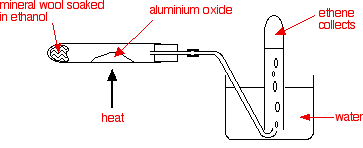
Summing Up the Chemical Properties
- Alkanes do not have a functional group and undergoes two chemical reactions: Combustion, Substitution
- In Alkenes the functional group is the carbon to carbon double bond, alkenes undergo three chemical reactions: Combustion, Addition and Hydration.
- In Alcohols, the functional group is the OH group. Alcohols undergo two chemical reactions: Combustion and Dehydration.
Conclusion
In this blog post we have gone through all the physical and chemical properties of hydrocarbons while remaining within the confines of the IGCSE Chemistry syllabus. The main focus in this blog were three homologous series: Alkane, Alkene and Alcohol. I hope you have found this blog post useful. Please browse my other organic chemistry notes if your concepts are not clear yet. If you are quite confident about organic chemistry, then try taking a simple quiz here and see what results you get.

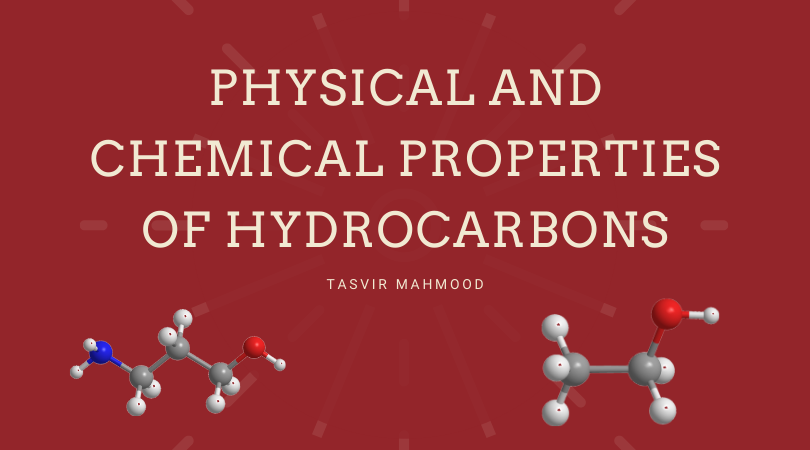
the site is provided more use full information about physical and chemical of various derivative of hydrocarbon